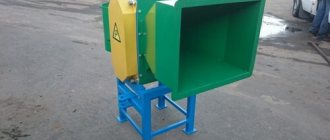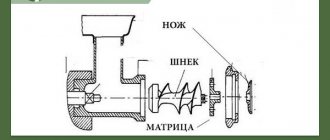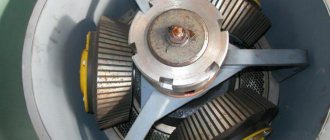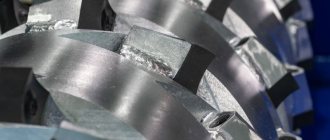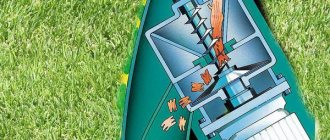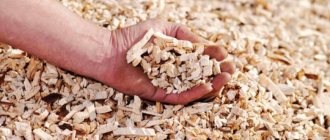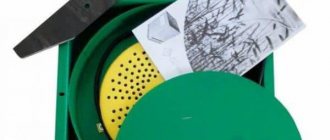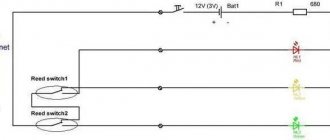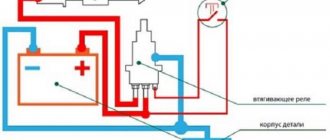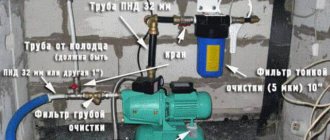A feed cutter is a simple and very convenient unit, which is indispensable for anyone who has a large number of livestock and poultry.
Designed for grinding various vegetables, herbs and grains, the unit can be not only factory-produced, but also made independently.
At the same time, a do-it-yourself feed cutter may not be inferior to purchased analogues in terms of reliability and performance. It can be made quite simply and quickly from almost any available materials.
Design and principle of operation
The main components of a homemade feed cutter are:
- Receiving tray, or hopper , is a structural element located above the working chamber (to the side of it) and used for storing crushed feed raw materials (grass, vegetables, fruits, grain).
- A working chamber with a knife rotating inside it - in this part of the feed cutter, raw materials are crushed with the sharp edges of moving knives.
- The power unit (motor) is designed to give the chopper knife a high rotation speed. It most often uses an electric motor from an electrical appliance (washing machine, juicer).
- The outlet pipe, or tray for crushed feed, is located, as a rule, in the lower part of the working chamber and serves to divert the result of the feed chopper into a container placed under it.
However, in some cases, due to the lack of materials and the need for quick manufacturing, this design is simplified, as a result of which the raw materials are placed directly into the working chamber and the crushed feed is subsequently poured out of it.
Grain crusher, feed cutter and grass cutter in one device
A grain crusher, feed cutter and grass cutter in one device is a fairly multifunctional device that allows you to process a wide variety of raw materials. The design of such a device allows you to grind grain, corn, barley, as well as chop grass, root crops and vegetables.
Depending on what kind of raw material is crushed, the performance indicator will be different. As a rule, chopping the grass takes longer, so the productivity will be slightly lower.
It has been scientifically proven that crushed feed is better absorbed in the body of animals, significantly increasing their productivity.
Drill grass cutter
A simple, but quite productive homemade grass cutter can be made from an electric tool such as a drill as follows:
- A hole with a diameter of 12 mm is made in the middle of the seat of a simple wooden stool.
- A UPC 201 bearing assembly is attached to the narrow wooden end of a 20x40 mm wooden block.
- The block, together with the bearing assembly, is attached to the back of the stool seat. In this case, the inner hole of the bearing and the similar one drilled in the seat of the stool must completely coincide (be coaxial).
- A galvanized 12-liter bucket with a 12 mm hole drilled in the center of its bottom is secured to the stool using short self-tapping screws.
- The shaft for the grass cutter knife is made from a durable rod with a diameter of 12 mm. To do this, an M12 thread is cut at one end of it, after which. By pushing it with the other end through the holes in the bottom of the bucket and the seat of the stool, it is pressed into the bearing. In this case, the length of the threaded rod protruding inside the bucket should be no more than 10-15 mm. The length of the lower end is selected taking into account the size of the drill used: it should be such that when the shaft is clamped in the chuck of a vertically installed tool, it rests on the floor and is stable.
- A diamond-shaped knife 10-180 mm long and 35-40 mm wide is cut from durable tool steel.
- The narrow ends and ends of the knife are sharpened on one side.
- The knife is installed on the working shaft and secured with a nut.
A simple drill with a power of 850-1000 W is used as a drive for such a grass cutter. The chopped grass is loaded in small portions when the drive is turned on, and the container must be closed with a lid.
After the working chamber of the grass cutter is filled with chopped food, tilt the stool with the bucket and pour it into a larger container.
Important! If there is no metal bucket available, under no circumstances should it be replaced with a plastic one - such a seemingly profitable and simple way out of the current situation can lead to disastrous consequences in the future. The fact is that if the knife is destroyed, this material will not be able to protect a person nearby from metal fragments flying at high speed.
Homemade apple, potato, tomato crusher
The technology for assembling a homemade crusher for vegetables and fruits used as food consists of the following steps:
- Making a working chamber - any old boiler will do for this. A hole is made in the center of its bottom, and a rectangular window is cut on the side, to which a small box is welded.
- A disk with a diameter 15-20 mm smaller than that of the bottom of the working chamber is cut out of metal 3 mm thick.
- A hole is made in the center of the cut out disk.
- Stepping back 20-30 mm from the central hole and the edges of the disk, 4 oval-shaped slits are made on the disk for knives. The angle between two adjacent slots should be 900.
- According to the size of the slots, 4 blanks are made from a 30x30 mm corner. In the outer plane of one of the corner shelves, 2 oblong adjustment holes are drilled. The distance between them is measured and recorded.
- Blanks from the corners with the ends of the shelves are welded to the side of the oblong slots. In this case, the adjustment holes should be located on the outer plane of the shelf that faces directly to the slot.
- To drain the crushed feed from the tank into the receiving tray, two rubber elastic strips are also attached to the lower surface of the disk.
- 4 knives with one-sided sharpening are made from rapid cloth. After releasing them on the fire, 2 holes are drilled into them. In this case, the distance between them is equal to the same value between the adjustment holes on the corners.
- A frame with legs is welded from the corner.
- The tank is welded to the frame.
- Next to the tank, an engine with a power of 500-700 W is attached to the frame using 2-3 bolts. Before installing it on the frame, a seam (driven) is attached to the motor shaft.
- A shaft for a disk with knives is made from a strong rod. A thread is cut at one end, and a groove for a keyed joint is cut at the other.
- The disk with knives is installed on the shaft.
- The shaft is inserted into a hole in the bottom of the tank.
- A second pulley (drive) is attached to the end of the shaft.
- The pulleys are connected by a belt.
- A button to turn the engine on/off is mounted at the end of the stand.
- The motor is connected to the button and to the electrical network.
- To eliminate the need for human participation in the process of grinding raw materials placed in the device, a special stop-bar is attached to the inner wall of its tank, resting against which, the raw materials will be crushed faster by the disc knives.
- To prevent electric shock, the frame of the feed cutter is grounded.
Grass chopper
First, let's look at making a grass chopper to feed calves or nettles to feed chickens. Such a unit will be required for those who have poultry and young animals of small and large horned livestock, pigs on their farm.
The materials you will need are: an electric motor with a speed of approximately 3000 rpm (such speeds are needed for finer cutting of the grass), a base, a working container, chopping knives, and tin for making a discharge sleeve.
The tools you will need are a welding machine, a grinder, a drill with metal drills, a set of keys, connecting elements (bolts, nuts, rivets).
Photo of a homemade herb chopper
The described chopper has a vertical design. All elements are attached to a base consisting of a square metal plate 4-5 mm thick. The legs are welded to this plate at the corners. The height of the legs should be selected according to the length of the electric motor, which will be located between the legs. In this case, the lower part of the engine should be located at a height of 15-20 cm from the ground. A hole is drilled in the center of the plate to output the electric motor shaft.
On the other side of the legs, a working container is attached to the base. This can be an old saucepan of significant volume, or you can use any other container, as long as it is cylindrical. You can attach it to the base with bolts, you just need to make the markings correctly and drill the holes. A rectangular hole is cut in the lower part of the container to drain the crushed food. A box is formed from the prepared tin, which must be attached to the container on the cut hole. It can be attached with rivets.
Knives can be made from an old wood saw blade. Two strips 5 cm wide are cut and the length is selected according to the diameter of the container (the knives should not reach the walls of the container by about 5 cm). Holes are made in the center of the strips. The edges of the knives are sharpened. The knives are installed on their axis in a cross.
To secure the knives to the electric motor shaft, you will need to make a special adapter, which, on one side, fits onto the shaft and is secured to it; on the other hand, the knives will be placed on the adapter. On this side you will need to cut a thread to firmly fix the knives with a nut.
Arrangement of knives in the grass chopper
After assembling all the elements into one structure, you can install a metal strip inside the container, which must be secured perpendicular to the inner surface of the container. It is important that this strip does not reach the knives. The purpose of this tape will be to prevent grass from wrapping around the knives.
After assembly, you will need to check the reliability of all connections, after which you can carry out a test run. Even when grinding feed, it is better to cover the container with some kind of lid to prevent grass from flying out of the container.
Grinder feed cutter
You can make a simple, but at the same time very productive and convenient feed cutter from an angle grinder (grinder) using the following technology:
- The frame of an old 40-50 liter aquarium is thoroughly cleaned of rust and welded if necessary.
- A pyramidal receptacle for crushed feed with a hole in the lower part (has a truncated top) is welded into one of the ends of the frame.
- A plate is cut out of thick metal according to the dimensions of the end part, and a hole is made in the center of it for the grinder gear shaft. Also, to load raw materials, a window is made in the plate, to which a funnel-shaped hopper or large diameter pipe (80-100 mm) is welded.
- A trapezoidal knife is made from tool steel.
- The grinder shaft is inserted into the hole in the plate, and the knife is secured to it using the lower support washer and a locking nut.
- The platinum is fixed at the end of the frame with 4-6 bolts.
- The body of the angle grinder is attached to the plate using a bracket.
When working on such a feed cutter, raw materials - various vegetables, fruits, grains - are placed in a funnel-shaped hopper and, under the influence of gravity, gradually fall onto a knife rotating at high speed, which chops them.
The finished feed enters the pyramidal receptacle and is poured through its truncated top into a container placed under the feed chopper.
Important! The finer and better the food is crushed, the better it will be eaten by a domestic animal (cow, pigs, rabbits) or poultry (chickens, ducks).
Do-it-yourself beet crusher – Special equipment
- Feed cutter-grater
- Grinder feed cutter
- Feed cutter from washing machine
Making a feed cutter with your own hands is quite simple.
In this case, you need to show a little ingenuity and work with your hands. In fact, you can make a structure from old and unnecessary things. A good feed chopper can be made from a washing machine.
In this article, we will tell you how to feed your pets without much difficulty.
Feed cutter-grater
The simplest version of a feed cutter that you can make with your own hands is an ordinary grater.
It should be clarified that this product is suitable only for small households.
In order to make this design, you don’t even need drawings.
We take a stainless steel sheet, the approximate size is height 50 and width 30 centimeters. We use a punch to make holes using the same principle as in a regular grater, which is found in any kitchen.
The top of each hole must be bent. For greater convenience, the design must be supplemented with a wooden frame.
The manual feed cutter is ready for use.
The entire manufacturing process will take you no more than an hour, but the benefits when feeding animals will be very noticeable.
Grinder feed cutter
To make this model, you will need a metal bucket.
It is recommended to use stainless steel buckets; galvanized ones may react with some types of feed and your animals will get food poisoning.
You need to make holes in the walls of the bucket, approximately 1.5 centimeters in diameter. The edges of the holes can be bent, as in the previous version. A small hole, approximately 1 centimeter in diameter, is also made in the bottom of the bucket.
After this, using metal corners and electric welding, a frame is constructed. The broken bucket is attached to the frame using a flange and seals.
You should get a movable drum; this will be the main working part of the feed cutter.
By the way, instead of a bucket, you can use a drum from an old washing machine, having previously made holes in it.
A receiving hopper for feed is installed above the drum. It can be made from sheets of metal or from another bucket, the bottom of which needs to be cut off.
In order to give the drum the required rotation speed, a grinder is attached to the rear flange using a bolt.
Having checked the reliability of the connections, you can begin testing; a simple do-it-yourself feed cutter from an angle grinder is ready.
The feed mass is poured from above into the receiving hopper. Under the influence of its own weight. The raw material presses on the drum, which acts as a grater.
The grinding speed is adjusted using the rotation speed of the grinder.
To prevent the crushed mass from flying out of the drum randomly, you can design a small door on door hinges.
It is worth noting that instead of an angle grinder, you can use an ordinary handle. In this case, you will get a large copy of a household meat grinder, only instead of minced meat, you will get a crushed lump for your livestock.
Before starting work, it is recommended to prepare drawings. The performance of such a design will directly depend on your capabilities. If you put in some effort, about 50 kilograms of feed will be guaranteed.
Feed cutter from washing machine
This is a more complex option, so before starting work, you need to make drawings. For a washing machine you will need a motor and a drum.
A hole must be drilled in the rear wall of the drum; the diameter must correspond to the motor shaft.
Along the edges, make four holes for mounting bolts.
A small hole is cut into one of the walls through which the finished food will be thrown out.
The cutting part is attached to the motor shaft using bolts. It is worth noting that for this design you will need two knives.
The first one looks like a propeller with slightly curved blades.
It is installed closer to the bottom of the drum and its purpose is to throw the feed up and push out the crushed particles from the feed cutter.
The second knife is the main cutting tool; it can be made from an old saw blade. The ends of this knife should be slightly deviated towards the bottom, this increases the performance of the design. It is better to sharpen with a double-edged blade.
It is worth noting that the fraction of feed directly depends on the time they remain in the working area of the feed cutter. It is recommended to supplement the outlet hole with a damper and make a small hopper where the crushed mass will fall.
According to farmers' reviews, such a feed cutter is guaranteed to crush about 100 kilograms of feed per hour. This design is well suited for chopping a variety of vegetables and herbs.
As you can see, making a feed cutter with your own hands is not at all difficult.
It is worth noting that these are working models that are successfully used on farms.
You can try to reproduce one of them in your backyard or take these options as a basis and design your own version of a feed chopper.
Feed choppers - which ones are better? DIY creation
Grinding of roughage animal feed is carried out for several reasons. Firstly, such food is much better eaten by animals and poultry, because hard structures are broken up during processing.
Secondly, small particles of food are better digested and absorbed by the body. And third, such forage can be mixed with protein and protein supplements until smooth, which increases their effectiveness.
Coarse raw materials are crushed using a special feed grinder.
Operating principle of the device
The feed chopper, depending on the model, differs in its design and operating features. The basic principle of operation for all types of shredders is the same:
- The grain prepared for processing is loaded into a receiving hopper or a receiving opening for small household models.
- Then, under the force of gravity, it enters the working area, where the crushing process begins. The crushing mechanism can be single-tiered or multi-tiered. In the first case, the grain passes through one section with crushing elements. In the second option, there are several such sections, each of which increases the degree of crushing.
- The processed raw materials pass through a conveyor system and are discharged into a special container or into an additional hopper of the device.
Feeding raw materials into the hopper of a household feed cutter
Hammer, cutting (knives) or grating elements act as crushing parts. Some options use combinations of several systems.
We also note that this device is used on the farm as a feed granule grinder.
This is necessary when you need to feed young poultry, and the fraction of the purchased feed is too large.
What does a universal feed chopper consist of?
The universal model is an example of using two grinding elements in one device. It uses a hammer and cutting system.
Such a machine consists of a power frame, necessary to stabilize vibrations from the machine and provide stability, and a body with a hopper for feeding feed, a working area and a conveyor mechanism.
Inside the device body there are two cylindrical chambers. Inside the first chamber there is a hammer crusher, which carries out the primary crushing of hard raw materials.
The second cylinder acts as a housing for the cutting machine. The basis for it is a knife, shaped like a propeller. It is attached to the cylinder body.
This body ensures further grinding of raw materials that have already passed the hammer crusher.
Both cylinders are connected to each other by a channel that directs the raw material. The channel has a square cross-section.
Its side walls have a movable fastening, and they are installed with an overlap.
This allows for a good level of raw material passage without losses and without channel corrosion from different vibration frequencies of the two mechanisms.
Not all universal grinders are equipped with a feed hopper. The household feed chopper is equipped only with a receiving hole, which leads directly to the work area.
The same goes for containers for processed products. For example, the Elicor feed chopper is a compact model that delivers chopped feed into a stand-alone container.
Do-it-yourself devices operate in exactly the same way.
Types of Shredding Machines
Depending on the type of raw materials processed, all crushing devices are divided into:
Industrial straw chopper
- machines for processing silage and straw;
- root cutters;
- crushers.
A straw silage cutter is a chopper of roughage. These devices are based on a disk or drum system for grinding raw materials. In a disk system, the cutting element is a rotor disk.
The drum system uses many knives that are evenly distributed over the entire surface of the chamber. The degree of grinding varies depending on the type of raw material being processed.
Feed cutter from a gas cylinder
Making a powerful and compact feed cutter from an old gas cylinder is as follows:
- All the gas is drained from the old cylinder.
- Using a hacksaw for metal, cut off the top of the cylinder.
- From a thick-walled pipe with a diameter of 50-60 cm, reinforcement number 12 (diameter 12 mm) and corners, a frame with 3 legs and 6 reinforcements connecting the frame in the upper and lower parts is welded.
- A 3-phase motor with a power of 2-2.5 kW is placed on the frame so that its shaft faces upward.
- A hole is drilled in the center of the bottom of the container, a window and a tray on the side for ready-made crushed food.
- In a similar way, as in the case of a vegetable crusher, a disk with 2 knives is made.
- The disk is connected to the motor shaft using a rod of the required length.
- The motor is connected to the network via a starter.
- A bolt is welded to one of the lower frame reinforcements to connect the unit to the ground loop.
This feed chopper, unlike those described above, has a very high engine power, which directly affects how much electricity it will consume. However, since its operating time, even when the tank is fully loaded, does not exceed 5-7 minutes, the electricity consumption will not be too large.
Washing machine feed chopper
The design of such a homemade device consists of:
- Tank from an activator-type washing machine (with vertical loading, without a rotating drum).
- A two-blade sharp chopper knife mounted on the activator shaft instead of a disk for mixing water.
- A tray for crushed feed, which is a continuation of the extended drain hole of the tank, with a pipe with a diameter of 50-60 mm inserted into it.
- Square frame on 4 legs.
- A motor connected to the chopper shaft using a V-belt drive (two pulleys and a belt).
- Engine start buttons.
- Cable for connecting the feed chopper to the network.
Juicy feed chopper
For those keeping pigs and cattle on their farm, it would be a good idea to have a succulent feed chopper. It will be needed for grinding root vegetables for further preparation of feed consisting of several ingredients.
There are several design options for succulent feed choppers, but we will not consider them all. Let's consider a version of a chopper that is structurally similar to the one described, that is, vertical.
Drawing of a vertical succulent feed chopper
1 - hopper, 2 - damper in open position, 3 - exit window, 4 - bumper belt, 5 - cutting device, 6 - start button, 7 - electric motor, 8 - tripod.
You will need material for the base, an electric motor, a cylindrical container, material for making a knife and a box for discharging crushed feed. The tools used are those described above.
The design is the same: a base with an electric motor attached to the bottom and a container on top. A shaft is inserted inside the container, onto which the cutting element is attached.
Advantages of DIY feed choppers
The main advantages of homemade feed choppers are:
- Cheap and relatively easy to manufacture. A do-it-yourself feed chopper will cost 3-5 times less than its factory counterpart, allowing you to save from 4,000 to 7,000 rubles.
- High performance. Such units can grind up to 100-150 kg of raw materials per hour.
- Ease of repair and improvement. A homemade feed chopper can be very easily improved.
- High-quality grinding of the supplied feed . The high rotation speed of sharp knives allows the units to sufficiently and uniformly grind all the raw materials placed in them.
The main disadvantage of such units is their noise - the knives rotating at a speed of at least a thousand revolutions per minute, chopping the food, make a very loud noise.
Ready-made feed chopper options
On the Russian market of agricultural products there are quite a lot of different options for such devices, combining several purposes. Let's look at the most popular devices, including a grass cutter, a feed cutter and a grain crusher.
ElectroMash IKB-003
IKB-003, produced at , is a feed chopper, but it combines several additional functions - grass cutters and grain crushers.
The design of the unit itself, like that of a grain crusher for farming and households, is quite simple, which allows it to be operated by people who do not have special technical skills.
Using this device, you can grind a fairly wide range of all kinds of raw materials: potatoes, beets, hay, carrots, grain, barley, etc. The design of this device includes removable sieves and gratings, by changing which you can use the unit as a grass cutter or grain crusher.
IKB-003
Technical characteristics of IKB-003:
- power consumption indicator - 1150 W;
- rotation - 12 thousand revolutions per minute;
- total weight – 8 kg;
- unit length – 36 cm;
- unit width – 31 cm;
- unit height – 31 cm;
- productivity (for grain) – 240 kg/h;
- productivity (for grass) – 150 kg/h;
- productivity (for root crops) – 900 kg/h.
A distinctive feature of IKB-003 is that it operates for a fairly long time without stopping - about 6 hours in a row. Considering all this, the price of this device, which is approximately 3,700 rubles, seems extremely attractive.
Feed chopper IK-07
IK-07 belongs to the category of feed choppers that combine additional functionality. With its help, you can grind not only ready-made feed, but also raw materials such as grain, legumes, vegetables and fruits, potatoes, grass, etc.
The walk-behind tractor is one of the most widely used types of equipment for caring for your site. Here is an article about what kind of oil should be poured into a walk-behind tractor.
The process of planting potatoes requires a lot of time and significant physical effort. With a potato planter for MTZ 82, work will become much easier and planting productivity will increase.
Mini tractors are very popular and widely used in housing and communal services, on construction sites and in agriculture. The Scout minitractor is strength, efficiency and durability.
The design of this device uses a universal knife, which is suitable for chopping grass and root vegetables. At the same time, the device supports the inertial release of processed grain, which significantly improves the quality of grinding.
IK-07
Technical characteristics of IK-07:
- power consumption indicator - 1500 W;
- total weight – 7.5 kg;
- unit length – 31 cm;
- unit width – 31 cm;
- unit height – 34 cm;
- productivity (for grain) – 350 kg/h;
- productivity (for grass) – 150 kg/h;
- productivity (for root crops) – 600 kg/h.
The average cost of this device is about 2800 rubles.
Crusher Zubr 2a
The Zubr 2a grain crusher also combines both a grass cutter and a feed chopper. Thanks to this versatility, this unit is among the best-selling in the agricultural sector.
One of the main features of this grain crusher is its unpretentiousness to environmental conditions, which is expressed in the ability to function in a fairly wide temperature range - from -250C to +400C.
Equally reliable and unpretentious are the grain crushers Shmel, Khryusha, Cyclone, and Kolos. The Zubr 2a design uses two removable sieves of different diameters - 2 and 4 mm, respectively. Thanks to this, you can adjust the degree of grinding, making the grinding coarser or, conversely, finer.
Bison 2a
In order for the device to perform the functions of a feed cutter, you need to take knives for grinding grain and a sieve, replacing them with a special grater included in the kit.
Technical characteristics of IK-07:
- power consumption indicator - 1800 W;
- total weight – 17 kg;
- unit length – 44.5 cm;
- unit width – 51.5 cm;
- unit height – 29.5 cm;
- productivity (for grain) – 180 kg/h;
- productivity (for root crops) – 650 kg/h;
- rotation - 3 thousand revolutions per minute.
The cost of this model is about 4,500 rubles, depending on the region of sale.
Elicor 4 device
Elikor 4 is a multifunctional device capable of chopping grass, root vegetables and grain crops. The design of this unit is quite typical for similar devices, which includes a grinding chamber and a hopper for loaded raw materials.
Also included are removable sieves of various diameters, as well as a disk grater, which allows you to grind feed and grass.
Elikor 4
Technical characteristics of Elikor 4:
- power consumption indicator - 1700 W;
- total weight – 16.5 kg;
- unit length – 51.5 cm;
- unit width – 29.5 cm;
- unit height – 75 cm;
- productivity (for grain) – 180 kg/h;
- productivity (for root crops) – 480 kg/h;
- productivity (for grass) – 380 kg/h;
- rotation - 3 thousand revolutions per minute.
The price for this unit is about 6,500 rubles.
Do-it-yourself feed cutter for root crops
Planning to simplify the care of their pets, many farmers prefer to purchase special household grinders, which allow them to process an impressive amount of raw materials into feed of the required fraction. At the same time, their cost is quite high, which is why many make the units themselves.
The simplest vegetable cutter can be made with your own hands in a short time, and its assembly will require a minimal amount of material. In terms of its performance indicators and functionality, it will not differ from purchased analogues, but its cost will be significantly lower.
There are several types of homemade units, among which it is worth mentioning:
- manual feed cutter for root crops;
- model from an angle grinder;
- drill device;
- device made from a barrel/gas cylinder;
- craft from a washing machine.
It must be remembered that a homemade device may not withstand the loads of intensive use, which is why it is recommended to operate the unit intermittently.
How the device works
Before you figure out how to make a feed chopper from a washing machine or other variations of a similar device, you should study the principle of its operation and the main design elements. The most important components of any homemade or purchased cutting model include:
- bunker - designed for storing processed raw materials;
- working chamber - used for grinding grain and root crops to the desired fraction;
- motor - responsible for rotating the knives;
- output hopper - used to supply finished products.
If desired, the design can be changed by the master towards simplification, which will reduce the list of necessary materials. For example, it is possible to supply feed directly into the chamber, eliminating the use of the input hopper.
The principle of operation of the unit is extremely simple - the raw material enters the working chamber, where it is crushed by the working parts to the desired state. It is then fed into the output hopper, after which it is used to feed livestock and poultry.
How to make a grater for beetroot
In agriculture, having available tools is very necessary, since the process of raising livestock or poultry takes a lot of time and causes a lot of trouble.
Designs such as a feed cutter will make work easier and make it possible to provide all animals with food on the farm.
A large number of animals will not allow you to make food manually; there is simply not enough time for this; various devices will help you cope with the tasks.
Design and technical description
A mechanical product will require a motor in the design. A single-phase motor is used with a prepared bushing, which is made in the form of an adapter.
The emphasis of the cutting knife is created by the legs, which are fixed to the plate through an adapter; their purpose is to release the finished product from the container.
The blade mount of a DIY feed chopper should be recessed into the design for a more consistent product output.
Making a body with your own hands requires the use of a steel pipe with a diameter of at least 30 cm, with a pre-prepared hole for the feed to exit. The structure is fastened to a support or wooden board, to which metal corners or studs are attached. The feed cutter drum is secured by welding to the corners, just like the engine.
Scheme of a homemade feed cutter
The housing has a front cover through which feed is loaded. The back cover serves as access to the cutting element and has a hole designed for unscrewing the bolt securing the knives. The front cover is complemented by a feed supply structure made of metal plate. The body is secured with metal plates around the perimeter by welding.
Principle of operation
When the electric motor starts, the mass for grinding is fed into the loading hole with your own hands. The knives rotate at low speed, cutting the product into the required pieces, the blades remove the finished mass to the outlet.
By adjusting the gap between the cutting edges and the plate, you can achieve cutting quality and process different raw materials. The harvested feed is fed against the location of the stems to increase speed and also to prevent clogging of the structure.
An example of a do-it-yourself feed cutter
For increased productivity, the knives are installed in a cross-shape. If necessary, an electric motor with a power of 3000 rpm is installed. Drawings of a homemade feed chopper will help you calculate the productivity and degree of cutting of raw materials.
Advantages of do-it-yourself feed choppers
The main advantages of a homemade feed cutter is that it can be adapted to meet the necessary needs. A homemade design can be made from improvised materials available on the farm.
Making the simplest feed cutter involves using a stainless steel tin bucket; more complex designs are made from an old washing machine.
Using a grinder or a high-speed drill in feed cutting also provides the possibility of cutting grass varieties of feed. All designs and accessories of a self-made feed cutter are made according to drawings.
Types of Shredders
There are different types of feed for livestock and poultry, succulent types of feed, grain and grass varieties. Each design implies manufacturing for convenient use and the production of a high-quality product.
Homemade grain grinder
The variety of designs makes it possible to use the device in various fields. We produce manual feed cutters with a track mechanism, straw cutters, as well as hand mills.
Do-it-yourself mechanized feed cutters are, in most cases, equipped with electric motors for maximum productivity in household or industrial settings.
There are universal devices that can grind various types of feed by replacing the cutting element.
Juicy feed chopper
Juicy feed is crushed using a grater with large notches. When the process requires mechanization, an electric motor is used, to which a bucket and grater are attached.
The feed cutter is manufactured in accordance with a pre-prepared drawing; the bucket is reinforced by welded strips at the edging, with a width of 1 cm.
Holes for friends are made across the entire area of the bucket in the desired order.
To make the frame, a small table is used, which is installed a few centimeters below the rear part.
Filling with food uses a homemade box, which is installed at an angle of up to 40⁰ relative to the main container. At the very bottom there is a tray for collecting finished products.
The low-speed engine drives the chopper, which is located as close to the walls as possible for better grinding.
Cereal grinder
Grain crops are processed using a universal type of feed cutter. The main difference is the use of a different type of cutting element and engine speed.
The presence of a mesh in the design allows you to regulate the degree of grinding of grain crops; the throughput is controlled by opening the door.
For a reliable slave, a single-phase two-speed motor with a maximum speed of up to 3000 per minute is used.
Electric feed cutter from a washing machine
If a craftsman is interested in a do-it-yourself feed crusher, he should pay attention to the most efficient and easy-to-use variation of the unit, made from a washing machine. In order to successfully create such a product, you will need to adhere to the simplest algorithm of actions:
- Remove the motor and drum from the washing machine.
- Drill a hole in the back of the drum so that it is sized to match the motor shaft. You will also need to make holes for fasteners.
- In one of the walls you will need to create an outlet for the finished product using a metal part that will need to be fixed to the drum.
- Make cutting elements - the first resembles a propeller, is mounted closer to the bottom of the working chamber, and the second is on top.
At this point, the manufacture of the unit can be considered complete, however, if desired, the master can make a convenient stand, as well as implement other elements to increase ease of use.
Grinder root vegetable grinder
Homemade units can be made from various devices, for example, from a grinder saw. To do this, you will need to select a suitable tank for the working chamber, and then perform the following steps:
- Install a raw material receiver, which can be made from sheet metal.
- A hole is cut in the central part of the body corresponding to the gearbox shaft of the angle grinder.
- Make a knife using stainless steel and sharpen it.
- Install it inside the body, attach the angle grinder shaft.
Manual chopping for vegetables
If in the process of agricultural activity there is a need to prepare a small amount of food for several pets, you can make a simple manual cut for vegetables. Its operating principle is similar to a grater, but the productivity is significantly higher. This option is perfect in cases where the farm does not have access to a source of electricity.
You can make the device by following the following instructions:
- Break off the handle of a galvanized bucket, cut out the bottom and drill holes in the walls. At the same time, the edges should be as sharp as possible.
- Cover the structure with stiffening ribs.
- Pull a piece of reinforcement through the holes, circle it around the edges of the product and form a handle.
- Install a receiver in the form of a metal or wood box without a bottom on top of the structure, secure it with self-tapping screws.
After successfully manufacturing the main parts of the structure, it is necessary to prepare a kind of table on which it will be used. The device will work by rotating the handle, crushing the raw material under the influence of its gravity.
How to make a feed cutter with your own hands
In this article I will tell you how to make a feed cutter yourself from scrap materials, so the sizes of the component parts will depend on what is at hand.
We make the body of the feed cutter from an iron tank by cutting holes in the bottom for the exit of the finished product, as shown in the figure below.
The narrower the holes you cut, the better the feed will be crushed.
Do-it-yourself feed cutter for beetroot - Metalist's Guide
In agriculture, having available tools is very necessary, since the process of raising livestock or poultry takes a lot of time and causes a lot of trouble.
Designs such as a feed cutter will make work easier and make it possible to provide all animals with food on the farm.
A large number of animals will not allow you to make food manually; there is simply not enough time for this; various devices will help you cope with the tasks.
Homemade feed cutter
DIY feed cutter knife
A knife for a feed cutter must be made of durable metal so that it does not tear due to centripetal acceleration during operation. If such material is not at hand, but you need to make a knife, then sharpen the ends with a triangle, lightening the weight at the edges. This approach will increase the safety of the structure, but will weaken the inertia, which will have a bad effect on the operation of the structure if it is equipped with a weak electric motor.
On the side of the body, we weld a bearing or bushing, which will act as a seat for the end of the axle (calibrated in size above the bushing/thread).
Instead of a washer, it is better to use a small bearing or a thicker bushing (I wore it out after two hundred buckets of potatoes, and I replaced it with three).
When assembling the feed cutter, be sure to leave a gap in the places where the electric motor is mounted so that it can move around a little. Since you will not be able to make a perfectly straight shaft and your unit will vibrate when the motor rotates, which means a rigid mount will lead to failure.
DIY electric feed cutter
For our feed cutter we will use an electric motor from an old washing machine, having obtained it, do not forget to get a capacitor or a special switch that activates the starting winding during start-up (without this, you will not be able to start the installation).
Connection diagram for the motor in an electric feed cutter.
The starting winding gives a starting impulse to the electric motor and then turns off (the capacitor charges and stops passing electric current), and the motor continues to rotate thanks to the working winding.
Instead of a capacitor, it is possible to use a switch in the form of a normally open contact button, which is pressed for a couple of seconds and then released.
